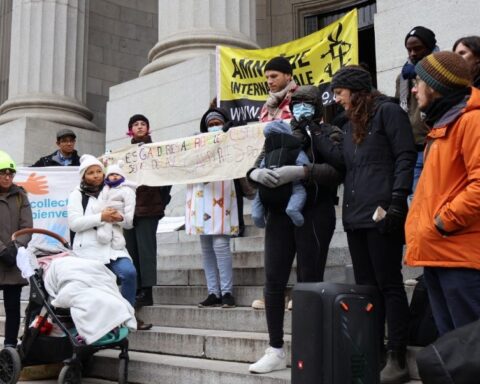I grew up in Québec. We saw nuns in full habit everywhere: in schools, driving cars, the shopping centre. That Québec … steeped in religion, where penitents mounted the stairs to Montréal’s Oratoire St. Joseph on their knees, has rapidly faded. Under the proposed new charter, a nun in habit, entering a Québec public school to teach, would be violating the Charter. The Charter is very concerned with how people’s choice of attire may offend others.
That’s why, when the current revisionist and, I must point out, minority government tries to claim that a neutral and religion-free society is a long-held Québec value that must be protected, I chortle. You see, if anyone is failing to understand and respect traditional Quebecois values, it is this Charter and this government.
The Marois government tells us this proposed Charter will affirm Québecois values. That’s modernist revisionist claptrap – a lie. Traditional Québec values involve home, hearth and faith.
Were Lalement and Brébeuf a couple of roving environmentalists? Nicolet a Muslim? Francois de Laval an atheist? How do you take all the saints out of Québec and its history? Ste. Catherine Street? Ste. Thérèse? La Calvère (the large cross atop Mont Royal)? Look no further than the French words to the national anthem: “Il sait porter la croix.”
This is a political wedge issue. It won’t get passed by the currently constituted Assemblée Nationale. Even if it did, it would never survive Federal Charter challenges. Suffice it to say, this is part of a thinly, ahem, veiled political agenda aimed at shoring up Mme Marois’s Francophone base outside Montréal and Québec City.
The Péquistes typically torque language and issues about who is un vrai Québecois, who is pure laine. They did it once before in attempting to eliminate all English references from the landscape and the history. Such attempts to legislate thinking don’t always take root. There once was a city renamed Leningrad. As a small island of seven million Francophones in a North American sea of 340 million others, Quebeckers have learned how to circle up the wagons to defend their culture against threats real or perceived. They’ve done well because Québec’s cultural contribution punches far above its weight.
Why this? Why now?
It seems there wasn’t a problem with ubiquitous Catholic symbols, or yarmulkes or turbans being worn by public servants in the preceding 250 years. But something has changed. In Québec, in France and other jurisdictions, governments are reacting to a more demanding and pious expression of Islam from growing numbers of Muslim immigrants.
On the soccer fields and elsewhere, Muslims, women mostly, are being thrust into the forefront. Ontario, a few years back grappled with whether Sharia law should have official standing. Now, many Quebeckers, feeling confronted by a small number of Muslim women who wear niqab or burqas, are rejecting the attire. It spreads: until quite recently there was never any problem with young Sikh men wearing turbans on a soccer field.
So the Québec government wants to draw a line before anyone tells them that the school cafeteria can no longer be serving ham sandwiches and every school must install a wudu (ritual cleansing area). They respond: “You can wear what you want at home and in private places … but not in a government office and some public places.”
All of this is playing out against the tableau of a Québec society in turmoil, having separated not so much from Canada, but from its rock-ribbed Catholic past. And it is still rebelling.
Attempting Revisionism
Part of the revisionism is the attempt to retrofit notions of separation of church and state into a modern Québec society. In no North American jurisdiction was there less wiggle room between church and state than there was in Québec, until the last 50 years. Québec, like Mexico during its La Cristiada anti-clerical period, is now expurgating all past symbols and representations of the Roman Catholic Church.
The Québec government writes that the best method to respond to religious pluralism…is to have NO public expression of religion. What Orwellian doublespeak! You see, they have actually chosen to favour a state religion over the others. That religion: Atheism.
To the contrary, India as a model. It is a secular state, which doesn’t mean a state without religion. It means a state where all religions are equal and none is accorded official status. India, of all places, homeland to four of the major world religions (Jainism, Hinduism, Buddhism, Sikhism) and fertile ground adopted by others.
India has a Hindu President, a Muslim Vice President, a turban-wearing Sikh Prime Minister, atheist Defence Minister, and the leader of the largest party is a Roman Catholic. Has this eroded or destroyed the historic Hinduism or the essential cultural identity of India? Not as much, some would argue, as the adoption of Western economic and social values. Québec take note.
Flexibility, please …
On the other side of the ledger, religious adherents need to show some flexibility, too. Time was, if you wanted to live a parochial religious life: you established your own remote colonies. Familiar examples include: old order Mennonites, Hutterites, Doukhobours, etc.
Common sense and flexibility must prevail. Just because you choose to live your religion in an extreme and anti-social way, I don’t have to hire you. For example, in parts of India, the Digambara Jains walk naked through the streets as an expression of faith. Sorry, no matter how much you invoke Charter rights, that’s not happening here. Be realistic; the society can’t be bent into a pretzel to accommodate anti-social practices – especially ones that are not obligatory.
Still, head coverings should not be as big a problem as face coverings. Relax, Québec provides us with illustrations of what is and isn’t acceptable. While these focus on world religions, what is going to happen when a First Nations employee of the Québec government wears a feather, carries a medicine bag, or a pipe? You see, once you start legislating this stuff, you stray into the maudlin.
What about an outdoor worker on a bitter cold winter day in Trois Rivières? Can he or she still wear a ski mask? Yes, I suppose, as long as he or she can prove it was worn for warmth, not belief.
About religious attire
There is a large wave of Muslim immigrants, many of whom have no experience living in a nation where Muslims are in the minority and in which Islam has no official status. It’s fair to point out that until recently, Muslim women could not cover their heads in Muslim-majority nations Tunisia and Turkey, and it was also once forbidden in Iran. Many Muslims believe such cover is cultural and personal, not fard (a religious obligation).
It’s also worth asking why a Pakistani or a Malaysian woman feels compelled to dress in what is essentially Arabian-style full body cover? It’s like a Russian wearing a kilt. The Bible doesn’t command the Mennonites to wear suspenders, I assure you. In other words, just because someone says it is “religious attire” doesn’t necessarily make it so. Some forms of accoutrements are strictly cultural and, importantly, are non-obligatory. So, if it is your wish to stand out as distinct from the society at large, you’re going to have to do that with the content of your character, and not your attire. Or don’t expect a public service job.
Some legal consequences
This Québec Charter will lose in a federal challenge based on Charter of Rights and Freedoms protections of religion and freedom of religious expression.
However, it is most vulnerable to a Charter 27 challenge: “This Charter shall be interpreted in a manner consistent with the preservation and enhancement of the multicultural heritage of Canadians.”
Québec is about to stray into the weeds and is going to be portrayed as intolerant.
And if Québec goes so far as to invoke the notwithstanding clause, imagine the scene when the Assemblée Nationale sergeant-in-arms forcibly removes a turbaned MNA from the assembly. On that day, I dare every sitting member to show up wearing a turban or hijab.
Richard M. Landau has been responsible for adjudicating disputes and enforcing a television network code of ethics in a religious broadcasting setting since 1992. He is a graduate of Carleton University and the University of Ottawa. A leader in interfaith dialogue, Mr. Landau has consulted with the U.K. Home Office and the White House Office of Community- and Faith-based Initiatives. He works closely with leadership in all of the major world religions. He is author of “What the World Needs to Know about Interfaith Dialogue.”





